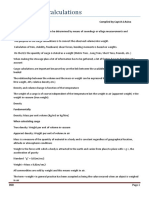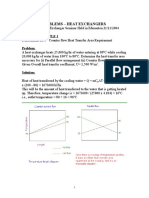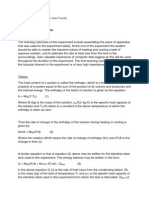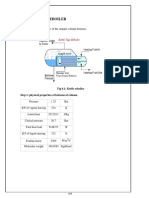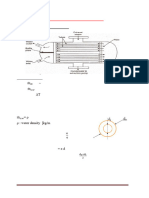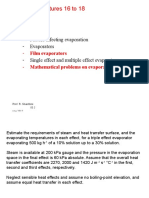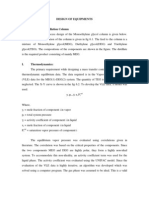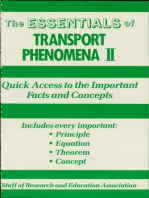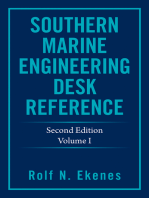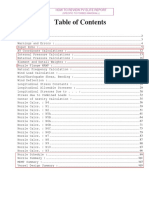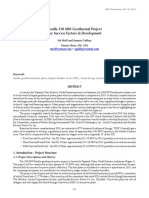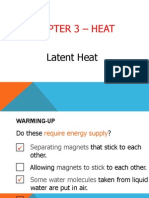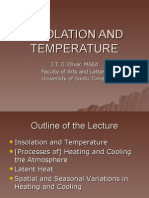Vent Size Imp For Pressure Vessels
Vent Size Imp For Pressure Vessels
Uploaded by
thomas_v501925Copyright:
Available Formats
Vent Size Imp For Pressure Vessels
Vent Size Imp For Pressure Vessels
Uploaded by
thomas_v501925Original Title
Copyright
Available Formats
Share this document
Did you find this document useful?
Is this content inappropriate?
Copyright:
Available Formats
Vent Size Imp For Pressure Vessels
Vent Size Imp For Pressure Vessels
Uploaded by
thomas_v501925Copyright:
Available Formats
Vent Size for Pressure Vessels
Vent sizing of pressure vessels and process equipments based on the way of usage.
Simply the presence of a Relief valve will relief the over pressure that was developed inside and
protects the reactor, Usually the reactor will be having a pressure resistance which is known as
Design pressure, if the reactor is felt with more than the design pressure, then there may be a
chance for explosion, and i said there may be a chance of explosion because after manufacturing of
reactor there will be some recommended tests that were to be done like pressure test, spark test[if
its a GLR], etc. While performing a pressure test, the vendor will cross the limit of design pressure
and gives a specification called Test Pressure, which means the pressure upto which the test was
carried out.
So, now i'll tell you when there is a need for Vent/Relief valve:
Vapour / Gas removal rate < = Vapour / Gas generation rate,
If the above condition is satisfied, then there requires a Relief valve / Vent for the system.
The major factors that will decide the Vent size were:
Maximum Vapour/Gas Generation rate,
Type of fluid inside the container, whether its a gas or liquid.
In case of Maximum generation rate, If we need to vent out Vapour / Gas that was generated, then
simply calculate the size from below equation:
V = A x S = 0.785 x D x D x S,
here, V = Volumetric flowrate in Cu.m / hr,
D is Diameter of Vent,A is Cross sectional area of the vent neck,
S is the velocity with which the vapour / gas will escape,
If the Container / Vessel is containing any gas, then there wont be any problem because if its a
solvent then there is a chance that solvent may be transform to vapours and create some vapour
pressure, but as it is a Gas then whatever the pressure that is accumulated, that will be kept off like
that.
One more important term, named as WCM [ Worst Credible Maloperation ], Which means the
highest pressure developed due to the maloperation responsible for the generation of vapour / Gas.
The calculation should obey the criteria, i.e., pressure that was developed during the WCM should
safely pass through the vent provided, or the Relief valve should respond to the WCM pressure with
a minimal response time
The approach to Relief sizing depends on 2 cases:
Fire case,
Reaction case
For a fire,
Vapour generation rate = Heat from fire / Latent heat of vaporization
For a chemical reaction,
Vapour generation rate = Reaction rate x Reaction Enthalpy / Latent heat of vaporization.
So after getting the vapour generation rate, you can go with above mentioned equation, V = A x S,
if there is any problem while calculation, then better go with a direct equation which was developed
& Proposed by Leung's Long form eqn.
A = [ m x q ] / G [ { (VxT/m)+(dP/dT)}^0.5 + {Cp x dT}^0.5 ] ^2
m - Initial mass in vessel (Kg),
q - Heat evolution rate per unit mass in vessel(Watt/Kg),
G - Vent flow capacity per unit area at set pressure(Kg/Sq.m),
V - Vessel volume(Cu.m),
T - Vessel temperature(K),
dP/dT - Rate of change of vapour pressure with temperature,
Cp - Specific heat ( J/Kg.K),
dT - difference of temperature between Maximum allowable pressure & Set pressure ( °K),
As per the Equilibrium rate model, the Value of G [ vent flow capacity] can be calculated as below,
G = (dP/dT) x SQRT(T/Cp) = hfg / [ Vfg x SQRT( Cp x T) ]
Consider a 10 KL reactor, having MOC SS316 with a design pressure of 3.2 Bar, and maximum
allowable pressure as 4.2 Bar, i.e., 30% excess to design pressure
Averag
e
Pressure Bar 3.2 4.16
Bubble point temperature
°C 110 120.5 115.3
Heat release rate ( watt/Kg) 1150 1660 1405
Liquid density ( Kg/Cu.m) 847 835 841
Vapor density (Kg/Cu.m) 3.75 4.62 4.19
Latent heat (KJ/Kg) 674.9 663.0 668.95
Liquid specific heat (KJ/Kg.K) 1.96 1.96 1.96
dP/dT 8300 9500
Vfg (Cu.m/Kg) 0.2655 0.2153 0.2404
Using equation developed from Equilibrium rate model,
At 3.2 Bar pressure, G = 0.5 x (dP/dT) x SQRT(T/C) = 0.5 * 8300 * SQRT( 383/1960)
= 2385 Kg/Sq.m S.
At 4.16 Bar Pressure, G = 0.5 * 9500 * SQRT(393.15/1960) = 2128.73 Kg/Sq.m S
The average value of 2385 & 2128.73 for G gives 2256.5 Kg/Sq.m S.
Now, we need to calculate the venting area from Leung's Long form eqn.
dP/dT = ( 4.16 - 3.2 ) x 10^5 / ( 120.5 - 110 ) = 9143 N/Sq.m K
A = [ 1500 * 1405 ] / 2256.5 [ { 10 * 288.5 * 9143/1500 }^0.5 +{1960 * 10.5 }^0.5] ^2
= 0.0122 Sq.m
D = SQRT(0.0122/0.785) = 0.125 m = 5" (inch)
You might also like
- A House Built On A Riverside...Document8 pagesA House Built On A Riverside...ErsanİmamoğullarıNo ratings yet
- Calculation and Design of Packed Column For AcidDocument14 pagesCalculation and Design of Packed Column For AcidDavid Lambert100% (1)
- Wolverine Tube Heat Transfer DATA BOOKch5 - 10Document20 pagesWolverine Tube Heat Transfer DATA BOOKch5 - 10ingemarquinteroNo ratings yet
- Tanker Cargo Calculations Jan-2018 2019Document9 pagesTanker Cargo Calculations Jan-2018 2019Gurjit Singh100% (5)
- Solutions To Basic and Applied Thermodynamics PK NAG SolutionsDocument265 pagesSolutions To Basic and Applied Thermodynamics PK NAG SolutionsVal Bulitas100% (2)
- Handbook: Process Systems Engineering & ManufacturingDocument9 pagesHandbook: Process Systems Engineering & Manufacturingthomas_v501925No ratings yet
- Cooling Tower Thermal Performance Calculation HMC 2Document465 pagesCooling Tower Thermal Performance Calculation HMC 2mehul10941No ratings yet
- Cooling Tower Thermal Performance Calculation - HMCDocument372 pagesCooling Tower Thermal Performance Calculation - HMCvkumaranNo ratings yet
- Refrigeration BasicsDocument78 pagesRefrigeration BasicsNihal Senanayake100% (1)
- Themo Lab 6Document13 pagesThemo Lab 6Zoraiz AbbasNo ratings yet
- ProjectDocument26 pagesProjectsiddharthkharat123No ratings yet
- Heat Transfer Lab ManualDocument40 pagesHeat Transfer Lab ManualRachit_Goyal25_10No ratings yet
- New Microsoft Word Document (2) 3Document160 pagesNew Microsoft Word Document (2) 3hamza A.laftaNo ratings yet
- Lab 2Document17 pagesLab 2Callum BiggsNo ratings yet
- Mohammedadil 224005Document23 pagesMohammedadil 224005MOAB FIFA mobileNo ratings yet
- Sample Problem StatementDocument2 pagesSample Problem Statementsunildubey02No ratings yet
- MUCLecture 2023 10247661Document96 pagesMUCLecture 2023 10247661toptutor894No ratings yet
- Worked Problems Heat ExchangersDocument18 pagesWorked Problems Heat Exchangers521 Balaji ONo ratings yet
- Design of Shell and Tube Heat ExchangerDocument42 pagesDesign of Shell and Tube Heat Exchanger3004 Divya Dharshini. MNo ratings yet
- Boiling and Condensation ProblemsDocument24 pagesBoiling and Condensation Problemskeerthi srijithNo ratings yet
- Block 2 Engineering Principles & Heat TransfersDocument188 pagesBlock 2 Engineering Principles & Heat TransfersBabu AravindNo ratings yet
- Refrigerantion Complete 2Document27 pagesRefrigerantion Complete 2Ricardo Wan Aguero50% (2)
- Transient Heat TransferDocument10 pagesTransient Heat TransferRimaz RameezNo ratings yet
- Tutorial Slides - Internal Forced Convection & Natural ConvectionDocument31 pagesTutorial Slides - Internal Forced Convection & Natural ConvectionVivaan Sharma75% (4)
- Cooling Tower ReportDocument27 pagesCooling Tower ReportWengLiLeongNo ratings yet
- PPP 5Document4 pagesPPP 5Smit patelNo ratings yet
- Cooling Tower 6MWDocument6 pagesCooling Tower 6MWtedfdfeNo ratings yet
- Water Cooling TowerDocument8 pagesWater Cooling TowerBalRam Dhiman100% (1)
- Xi - Cooling Tower - CheckDocument11 pagesXi - Cooling Tower - CheckJanine Glaiza Jaspe GallerosNo ratings yet
- Assignment 1: Shell and Tube Heat Exchanger Overall Heat Exchanger Value, U ValueDocument27 pagesAssignment 1: Shell and Tube Heat Exchanger Overall Heat Exchanger Value, U ValueAravind NaiduNo ratings yet
- 64-Numerical On boiling-15-Oct-2019Material - I - 15-Oct-2019 - Numericals - On - Boiling PDFDocument11 pages64-Numerical On boiling-15-Oct-2019Material - I - 15-Oct-2019 - Numericals - On - Boiling PDFsiva yandraNo ratings yet
- Cooling Tower Report FinalDocument7 pagesCooling Tower Report FinalNhlaka ZuluNo ratings yet
- Turbine Generator With Wood Scrap and FORESTATIONDocument24 pagesTurbine Generator With Wood Scrap and FORESTATIONDario Martin LobosNo ratings yet
- 03 Unit System and Characteristic of FluidDocument42 pages03 Unit System and Characteristic of FluidMuhammad Fakhri KusnanNo ratings yet
- Che Lab EvaporatorDocument6 pagesChe Lab EvaporatorAyobami AkindeleNo ratings yet
- Basic Design of A Heat ExchangerDocument10 pagesBasic Design of A Heat ExchangerKvspavan Kumar100% (1)
- Screenshot 2023-01-11 at 8.11.58 PMDocument15 pagesScreenshot 2023-01-11 at 8.11.58 PMAbdla DoskiNo ratings yet
- CONVERSIONDocument19 pagesCONVERSIONguzmanalluadNo ratings yet
- Laboratory Report 2 Venturimeter IDocument9 pagesLaboratory Report 2 Venturimeter IReyven ReconNo ratings yet
- Two Phase Vertical Separator SizingDocument4 pagesTwo Phase Vertical Separator Sizingkamal100% (2)
- Venturi Scrubber Design CalculationDocument2 pagesVenturi Scrubber Design CalculationAnil DhamankarNo ratings yet
- Forced Convection: Indian Institute of Technology PatnaDocument8 pagesForced Convection: Indian Institute of Technology PatnaPranav BajajNo ratings yet
- Daerator - Sizing - Vacuum BreakersDocument2 pagesDaerator - Sizing - Vacuum Breakerscirius_cool100% (1)
- Cooling EquipmentDocument15 pagesCooling EquipmentRomelyn Suyom PingkianNo ratings yet
- Design of Pilot Plant For The Production of Essential Oil From Eucalyptus LeavesDocument4 pagesDesign of Pilot Plant For The Production of Essential Oil From Eucalyptus LeavesjokishNo ratings yet
- 2 - Design of Steam Condenser & Feed Water HeatersDocument11 pages2 - Design of Steam Condenser & Feed Water HeatersOmar S. AliNo ratings yet
- Forced Convection Lab ManualDocument10 pagesForced Convection Lab Manualjohn paul.jaisonNo ratings yet
- Perancangan MenaraDocument18 pagesPerancangan Menaraogum_07No ratings yet
- Heat Mass 1Document12 pagesHeat Mass 1Eli Leopoldo Geneston100% (1)
- Index: S.No Name of The Experiment RemarksDocument9 pagesIndex: S.No Name of The Experiment RemarksArnab Dutta ChoudhuryNo ratings yet
- PM3125 Lectures 16to17 EvaporationDocument45 pagesPM3125 Lectures 16to17 EvaporationkapilNo ratings yet
- Lecture 6 - Heat Transfer EquipmentDocument72 pagesLecture 6 - Heat Transfer EquipmentLouie Gresula100% (1)
- Ethyleneglycol Design 2520of 2520equipmentsDocument41 pagesEthyleneglycol Design 2520of 2520equipmentsHardik Gandhi100% (1)
- Southern Marine Engineering Desk Reference: Second Edition Volume IFrom EverandSouthern Marine Engineering Desk Reference: Second Edition Volume INo ratings yet
- A Modern Course in Statistical PhysicsFrom EverandA Modern Course in Statistical PhysicsRating: 3.5 out of 5 stars3.5/5 (2)
- 08 - Pressure Drop & Flowrate-KarmanDocument2 pages08 - Pressure Drop & Flowrate-Karmanthomas_v501925No ratings yet
- VaporDocument99 pagesVaporthomas_v501925No ratings yet
- CondenserDocument79 pagesCondenserthomas_v501925No ratings yet
- Phase ChangeDocument52 pagesPhase Changethomas_v501925No ratings yet
- Cellulose-from-Cotton ImpDocument5 pagesCellulose-from-Cotton Impthomas_v501925No ratings yet
- Sales Catalogue: Turbo-Dryer®Document31 pagesSales Catalogue: Turbo-Dryer®thomas_v501925No ratings yet
- Isopropyl Alcohol Recovery by Heteroazeotropic Batch DistillationDocument10 pagesIsopropyl Alcohol Recovery by Heteroazeotropic Batch Distillationthomas_v501925No ratings yet
- NC ETP Veolia CompanyDocument19 pagesNC ETP Veolia Companythomas_v501925No ratings yet
- SuratTextileMills Annual-ReportDocument90 pagesSuratTextileMills Annual-Reportthomas_v501925No ratings yet
- Vogt Valves: Catalog and Application ManualDocument77 pagesVogt Valves: Catalog and Application Manualthomas_v501925No ratings yet
- A Case Study On Separation of IPA-water Mixture by Extractive Distillation Using Aspen PlusDocument8 pagesA Case Study On Separation of IPA-water Mixture by Extractive Distillation Using Aspen Plusthomas_v501925No ratings yet
- How To Review PV Elite Report: (Specific To Forbes Marshall)Document9 pagesHow To Review PV Elite Report: (Specific To Forbes Marshall)thomas_v501925No ratings yet
- Reactor Cooling JacketDocument2 pagesReactor Cooling Jacketthomas_v501925No ratings yet
- Tender Doc NIT 14 Jun 2019 GLR REACTOR 2019-20Document22 pagesTender Doc NIT 14 Jun 2019 GLR REACTOR 2019-20thomas_v501925No ratings yet
- Introduction of Htri XistDocument36 pagesIntroduction of Htri Xistthomas_v501925100% (1)
- Meat-Ds - Spin Flash Dryer System-UkDocument4 pagesMeat-Ds - Spin Flash Dryer System-Ukthomas_v501925No ratings yet
- Online Classes Recording ImpDocument22 pagesOnline Classes Recording Impthomas_v501925No ratings yet
- Assay by Titrimetry:: What Are These Known Impurity & Unknown Impurity ?Document3 pagesAssay by Titrimetry:: What Are These Known Impurity & Unknown Impurity ?thomas_v501925No ratings yet
- Sarulla 330 MW Geothermal Project Key Success Factors in DevelopmentDocument6 pagesSarulla 330 MW Geothermal Project Key Success Factors in Developmentkristiano97No ratings yet
- SUMMARY of Physics 9-10Document44 pagesSUMMARY of Physics 9-10freeuser3No ratings yet
- Latent HeatDocument21 pagesLatent HeatFiona RozarioNo ratings yet
- KUHES Thermodynamics 2Document13 pagesKUHES Thermodynamics 2DENACE JnrNo ratings yet
- Heat EffectsDocument3 pagesHeat EffectscarlNo ratings yet
- SPM 2003, Section C, No. 3 (20 Marks) : Chapter 4: HeatDocument4 pagesSPM 2003, Section C, No. 3 (20 Marks) : Chapter 4: HeatSJKT LDG BUKIT 9 LADANG BUKIT 9No ratings yet
- Physics SyllablesDocument42 pagesPhysics SyllablesCOLLINS AFESEHNo ratings yet
- 19a. Thermo Dynamics (365-400)Document36 pages19a. Thermo Dynamics (365-400)Pathan KausarNo ratings yet
- Physics 15 - Thermal Properties and Temperature - 2Document59 pagesPhysics 15 - Thermal Properties and Temperature - 2Hakim AbbasNo ratings yet
- HOTS (Mains+Adv) PhysicsDocument45 pagesHOTS (Mains+Adv) Physicsglp.20080205No ratings yet
- Grade 8 Science First Quarter 2017-2018Document3 pagesGrade 8 Science First Quarter 2017-2018gerald quijanoNo ratings yet
- I. Problem SolvingDocument4 pagesI. Problem SolvingEsther BarriosNo ratings yet
- 22.2-Thermal Properties and Temperature-Cie Igcse Physics Ext-Theory-QpDocument10 pages22.2-Thermal Properties and Temperature-Cie Igcse Physics Ext-Theory-QpDaniel goodchildNo ratings yet
- Thermal Physics O Level Note 27-Nov-2023Document13 pagesThermal Physics O Level Note 27-Nov-2023aliayanraza5No ratings yet
- Hvac TermsDocument8 pagesHvac TermsAvanish PatelNo ratings yet
- Physics NotesDocument48 pagesPhysics NotesAshley LimNo ratings yet
- Sepro 1 Appendix PDFDocument45 pagesSepro 1 Appendix PDFMeesaa KbaiiNo ratings yet
- Physical Pharmacy - 3rd Sem - Unit 2aDocument15 pagesPhysical Pharmacy - 3rd Sem - Unit 2aVishant Sirvi100% (1)
- MCQDocument4 pagesMCQJ Jeshwitha JosefaNo ratings yet
- AP Physics 2 NotesDocument130 pagesAP Physics 2 NotesmimiNo ratings yet
- Boilers and Steam Systems ..BoeDocument151 pagesBoilers and Steam Systems ..BoeMV AmohanAKarthicK100% (2)
- Unit 5Document14 pagesUnit 5Mr. Dtrap3236No ratings yet
- Thermal Properties of MatterDocument49 pagesThermal Properties of MatterAbhisheak DineshNo ratings yet
- Ib Phys DC ESQ B 231118 135653Document25 pagesIb Phys DC ESQ B 231118 135653sammeaan khanNo ratings yet
- Pinch Technology Report PDFDocument76 pagesPinch Technology Report PDFOpio IsaacNo ratings yet
- BANK QuestionsDocument33 pagesBANK QuestionsGuty GutierrNo ratings yet
- Insolation and TemperatureDocument17 pagesInsolation and Temperatureapi-3744104100% (1)
- Tech Note 01Document15 pagesTech Note 01José Alberto Hernández SánchezNo ratings yet
- Thermometery & Thermal ExpansionDocument19 pagesThermometery & Thermal ExpansionAlokNo ratings yet
- Food BiochemistryDocument48 pagesFood BiochemistryFombang AtamNo ratings yet




